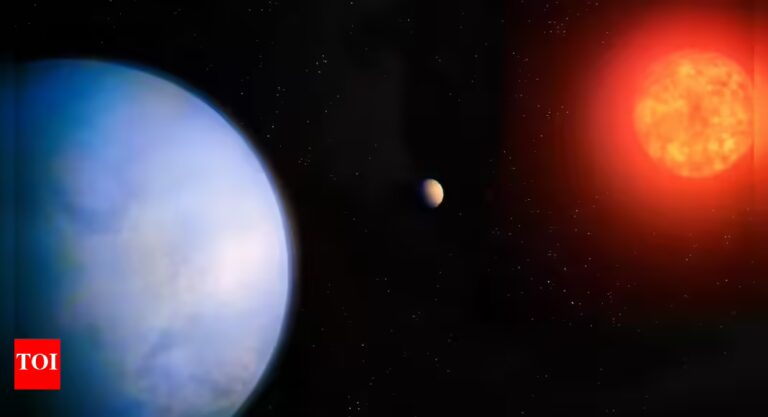Guess it’s time for Earth 2.0!Imagine a world so close to us in cosmic terms — just next door in our galactic neighborhood! As much as that sounds a bit Nolanesque, here’s the promising possibility — Interstellar might even come true!Astronomers may have just found a compelling candidate in the search for another Earth. Yes, you read that right! And now that a new exoplanet, dubbed GJ 251 c, lies just around 18 light-years away from our solar system and falls within the habitable zone of its star, the phrase “another Earth” seems less like science fiction and more like “maybe soon!”Intrigued much? Read on to know more about the “super-Earth.”
Another Earth around the block?
New findings suggest that such a world may exist — a planet not just anywhere, but within less than 20 light-years of our own solar system. That’s roughly a fifth of the width of our Milky Way’s disk across the local region. And as this exoplanet falls within the habitable zone of its star, it means it might, under the right conditions, support liquid water — a key ingredient for life as we know it.
A nearby exoplanet: What we know so far
Astronomers at the University of California, Irvine (UCI) and other institutions have identified a planet labeled GJ 251 c orbiting the star GJ 251 (also named Gliese 251), which lies only about 18 light-years away from our Solar System. The planet orbits the red dwarf star GJ 251 (also known as Lalande 21185) at a distance of roughly 18.2 light-years from Earth.Now, that’s exceptionally close in galactic terms, making it one of the nearest known exoplanets in the “habitable zone” category. Moreover, it orbits within the so-called habitable zone of its star, the region where, under the right conditions, liquid water might exist on a planet’s surface.
What makes it a ‘super-Earth’
What do we mean when we say “habitable zone?” It refers to the orbital band where a planet could maintain liquid water on its surface — assuming it has the right atmosphere. In the case of GJ 251 c, the planet sits in that zone, making it a strong candidate for further study. Furthermore, this planet has gotten the name “super-Earth” because its mass is measured at roughly 3.8 to 4 times that of Earth.However, it’s not yet confirmed whether GJ 251 c has the necessary atmosphere, magnetic field, or surface conditions to sustain life. Red dwarf stars such as GJ 251 can be active and may strip atmospheres from orbiting planets via stellar flares, so caution is warranted.
Why this discovery is ‘special’
First and foremost, it’s the factor of proximity. At about 18 light-years away (a light-year is roughly nine and a half trillion kilometers), GJ 251 c is extremely close in astronomical terms. This closeness means scientists have a better chance of studying it and its star in greater detail. Astronomers can even make use of next-gen telescopes for direct imaging and to study its atmosphere (if present) and composition more easily than distant exoplanets.Then comes the factor of habitability. Because it sits in the habitable zone, the planet could — theoretically — host liquid water. That is one of the key ingredients in our current understanding of supporting life. While larger than Earth, a “super-Earth” like this has a better chance of retaining an atmosphere and possibly liquid water than smaller, Mars-sized worlds. Also, being a rocky (or at least likely rocky) world rather than a gas giant enhances the possibility that it might resemble our Earth in structure.
What’s next
Although the new discovery is exciting and promising, we’ve yet to know its composition in detail — whether it has a substantial atmosphere, whether that atmosphere could shield harmful radiation, or if surface water exists. The star it orbits is an M-dwarf (a small red dwarf star), which typically has higher levels of stellar activity (flares, starspots) than our Sun, and that can erode or complicate the habitability of orbiting planets. Moreover, even though the planet lies in the habitable zone, orbital eccentricity, atmosphere loss, stellar activity, and internal heating can all interfere with habitability. For example, other nearby super-Earths have orbits that swing them into freezing and scorching extremes. Furthermore, the designation “habitable zone” is a necessary but not sufficient condition for life. Many planets in habitable zones turn out to be barren or hostile. Habitability requires many factors beyond distance from the star: planet composition, atmospheric pressure and composition, magnetic shielding, water availability, and geological activity. We have no direct evidence for those yet in this case.Now, as this discovery is promising — with next-generation telescopes (space- and ground-based) — astronomers will attempt to observe starlight filtered through or reflected by the planet’s atmosphere to search for key gases like oxygen, methane, or water vapor, as more precise measurements of the planet’s orbit, mass, and density will sharpen the understanding of its nature (rocky like Earth or more like a mini-Neptune).Finding such a planet so close only highlights that potentially habitable worlds may be more common and closer than we once thought. It not only encourages further study, but also triggers a shift in the line of questioning: it started from “Do habitable planets exist?”; now it’s “Which one do we study first?”
7 Earth-size planets found orbiting star, may hold life
Images are for reference only.Images and contents gathered automatic from google or 3rd party sources.All rights on the images and contents are with their legal original owners.
